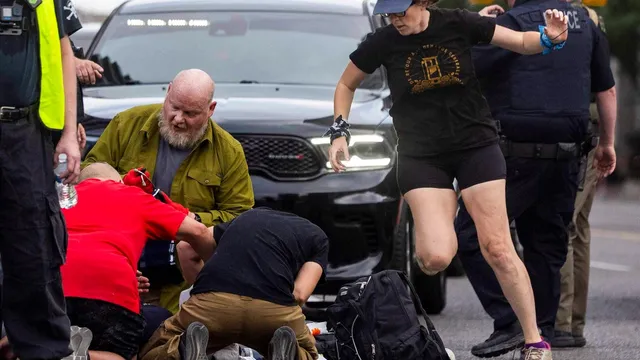
Protester shot and killed at No Kings rally by peacekeeper
2025-06-19 19:15- Arthur Folasa Ah Loo was shot and killed while attending a No Kings protest in Salt Lake City.
- The shooting occurred when a peacekeeper fired at a person brandishing a rifle, mistakenly striking Ah Loo.
- The tragic incident has raised concerns about the safety of protesters and the role of armed peacekeeping teams.
Express your sentiment!
Insights
In the United States, during a No Kings protest in Salt Lake City on a Saturday evening, Arthur Folasa Ah Loo, a 39-year-old fashion designer known for his work in celebrating Pacific Island artists, was fatally shot. The incident occurred when a member of the protest's peacekeeping team discharged a firearm while attempting to subdue a man who was allegedly brandishing an assault-style rifle. Tragically, the bullet meant for this individual struck Ah Loo instead, as he was an innocent bystander at the rally. Eyewitness accounts revealed the chaotic moment after the gunfire, with many protesters scattering for safety. The protest aimed at advocating for the rights of marginalized communities ended in tragedy, raising questions about the presence of armed peacekeeping teams at such events. Video footage shared on social media captured the chaos as the gunshots sent several people fleeing for cover. Authorities revealed that while the intended target, Arturo Gamboa, sustained minor injuries, Ah Loo did not survive the shooting and was pronounced dead at the hospital later that night. Arthur Ah Loo's background as a self-taught designer was highlighted by community members who remembered him fondly for his unyielding commitment to enriching the lives of those around him. Ah Loo, affectionately known as Afa, was married with two children and had participated in Season 17 of the television show Project Runway. His career focused on integrating his Samoan heritage with contemporary fashion, and he co-founded Creative Pacific to uplift artists from the Pacific Islands. The Salt Lake City protest had engaged a diverse crowd advocating for social justice and equity, making the violent turn of events particularly shocking. Following the shooting, local leaders called for a thorough investigation into the circumstances surrounding the incident. The tragedy has sparked discussions about the role of 'peacekeepers,' the effects of armed presence at protests, and calls for accountability ensuring participants' safety during peaceful demonstrations.
Contexts
The issue of gun control and its impact on protest safety is an increasingly relevant topic in contemporary society. Protests have historically served as critical platforms for expressing dissent and advocating for change. However, the presence of firearms at these events can escalate tensions and lead to violent confrontations, both among protesters and between protesters and law enforcement. The role of gun control in this context revolves around regulating access to firearms to mitigate risks during protests, thereby enhancing safety for participants and bystanders alike. Research indicates that areas with stricter gun control laws tend to experience lower rates of gun violence, suggesting a correlation between legislative measures and public safety outcomes. When protests occur in environments where firearms are prevalent, the potential for conflict intensifies. The introduction of weapons can lead to a heightened sense of fear, prompting individuals to act defensively or aggressively. Studies have shown that disarming protesters or limiting access to firearms during protests can significantly reduce the likelihood of deadly encounters. By implementing effective gun control measures, governments can create safer environments that foster peaceful demonstrations rather than violent clashes, ensuring that the right to free expression is upheld without compromising the safety of individuals involved. Moreover, the dialogue surrounding gun control in relation to protest safety is not just about legal frameworks but also includes cultural attitudes towards firearms. In some regions, firearms are seen as symbols of personal freedom and defense, which complicates public discourse on the necessity of gun regulation. Advocates for gun control argue that a reevaluation of these cultural perceptions, coupled with data-driven policy decision-making, can lead to improved safety outcomes during protests. Engaging communities in discussions about the implications of armed protests can foster a shared understanding of the need for balance between constitutional rights and public safety, leading to more cohesive and peaceful civic engagement. In conclusion, the intersection of gun control and protest safety is multifaceted and requires a thoughtful approach to policy formulation. Striking a balance between individual rights and collective security is paramount. By emphasizing public safety through effective gun regulation, governments can help ensure that protests remain peaceful and productive, rather than devolving into chaos and violence. As society moves forward, it will be essential to continue examining the implications of gun control within the context of civic participation, ensuring that all citizens can exercise their rights in a safe environment.